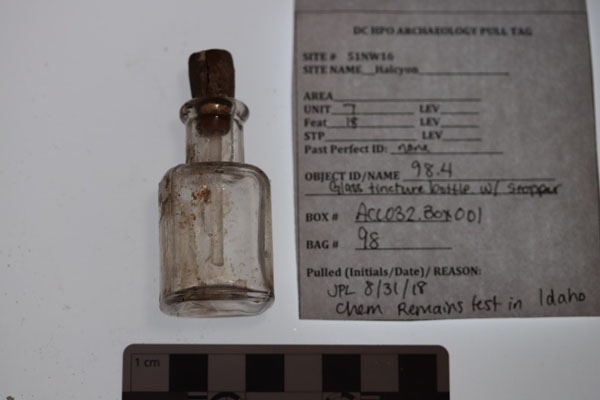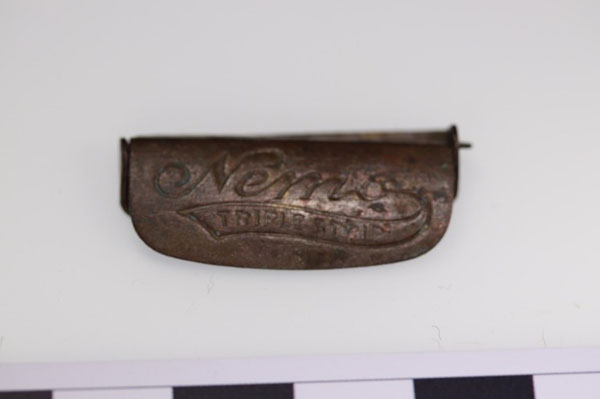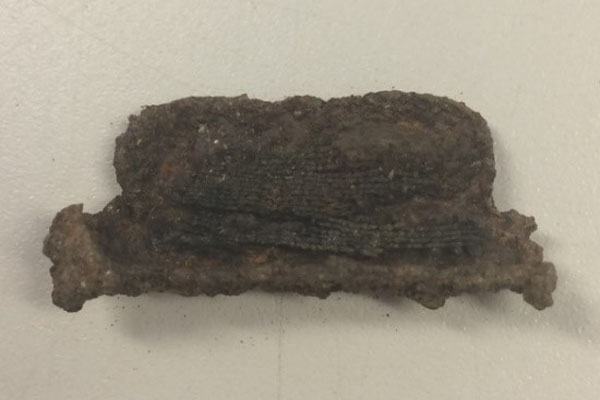Working with the Halcyon Collection 2: Applying for Major Dissertation Grants with a Collections’ Project
By Jennifer A. Lupu, PhD Candidate, Northwestern University

Perfume Bottle from the Halcyon House Collection with pull tag. This bottle was sent to Mark Warner and Ray Van Wandruszka at the University of Idaho for chemical remains testing.
Ok, so at long long last, I’ve returned to talk to you more about tips, strategies, and advice for doing graduate (or undergraduate) research with excavated collections. This post is mostly for PhD students, because it will discuss how to pitch a collections-based project to two major archaeology dissertation grants, the Wenner-Gren Dissertation Fieldwork Grant, and the National Science Foundation’s Doctoral Dissertation Improvement Grant (NSF DDIG). Each of these provides up to $20,000 in research funding, which can include things like travel, equipment, samples analysis, and other field and analysis costs. There are many other resources about applying to these grants, but none that I had found was specific to collections. This blog post will focus on how to pitch a collections’-based archaeological project to NSF and Wenner-Gren. First, I’ll explain why students with collections-based projects should apply for these grants. Then, I’ll discuss how to structure your proposal. I’ll focus in on methodology and budget, because these are distinctive for collections-based projects and crucial to securing funding.
Now, I’ll be totally honest here. I have had mixed success in applying for grants, but ultimately I did not get a major dissertation grant for my project. I agreed to write this blog series, about doing collections-based research as a student, while I was still waiting to hear the results of my proposals. As I went through the process of applying to these two grants, I did receive extremely positive reviews and made it to the second round of the Wenner-Gren twice. I learned so much along the way, and I want to share that advice with other graduate students. But of course, this is just a reflection of my own experience and conversations with peers and mentors, so take it with a grain of salt. BUT, if you, like me, are unsuccessful at getting these big sources of funding, do not despair! In my third and final post, I will talk about how to fund a collections’ based project without big grants. I’m fortunate to have been successful at receiiving some funding from other sources, and I’ll be discussing the lesser-known funding opportunities for collections-based research specifically in my third and final post of this series.
Why Should I apply at all?
Before I applied, I heard a lot of discouraging things about applying to grants with a collections’-based project, including that there’s no point in applying at all. I think it’s still important to apply, but I did find that some reviewers were dubious about a collections’-based project. However, I found at least one fully collections-based NSF DDIG that was funded, and both NSF and Wenner-Gren claim they are open to collections-based research. My Wenner-Gren proposal received favorable reviews both times I applied, and made it through to the second round of consideration. The first time I applied, however, I got the comment that a post-excavation project should not be as expensive as an excavation-based project, and this was one reason my proposal was not accepted. This is a commonly held myth that you will have to confront if you apply with a collections-based project. In actuality, many archaeological projects face major funding issues because they do not budget sufficiently for artifact processing, analysis, and conservation. This is part of what has led to an extreme burden of under-studied collections. Every graduate student should attempt to come up with a dream project that uses the full grant amount effectively. Whether it is a field project or a collections-based project, that money can be well-spent on costs that will forward anthropological and archaeological research. Collections-based research requires its own set of expertise and skills, and it is important that key archaeological funding sources support graduate students in getting the training they need to be collections’ specialists in their careers.
How to Frame your Proposal:
Basically, you should pitch this project much the way you’d pitch a more traditional excavation-based field project. Voss points out that in both collections- and excavation-based projects, knowledge is produced through the encounter between archaeologist and artifact in much the same way (2012). As I explained in blog post 1 of this series (here- add link), collections-based research is important, ethical, and environmentally sustainable. We need more students to be trained in collections-based approaches. BUT, in order to effectively work with excavated collections, you ideally should have experience on excavations and understand the excavation process. In addition to several seasons on a field school project, I spend a few years working as a CRM archaeologist in the Mid-Atlantic. When I began working with excavated collections, I needed to use my knowledge of excavation to understand the field notes, profile drawings, and descriptions of proveniences in order to understand the context of the artifacts. I scheduled a meeting with one of the archaeologists who had originally worked on the Halcyon House excavation in the 1980s, Dr. Elizabeth Crowell, and asked her questions about the excavation and clarified any uncertainties with site forms and documentation.
I tailored my project to NSF and Wenner-Gren in different ways. For NSF, it can be helpful to draw on Kintigh et al’s article “Grand Challenges for Archaeolgy.” (https://www.cambridge.org/core/journals/american-antiquity/article/abs/grand-challenges-for-archaeology/D1CE7CB50C3C5A1854B5A48D71B17AD9). I tried to use more classic anthropology theory, such as Binford and Flannery’s discussions of settlement analysis, theoretical framings of “the household” as a unit of analysis, and practice theory. I constructed hypotheses that could be proven or invalidated by the data. One way to do this is to propose to look at multiple collections together, and create hypotheses about how the material record might vary across a city or region, or over time. I proposed to build on my preliminary research with the Halcyon House Collection by looking at glass bottle artifacts in multiple collections across the city during the same time period. I propsed to use the Halcyon Collection as a key case study in a larger project that drew in comparative collections. In my grant applications, I emphasized that the collections I planned to study were “archaeologically excavated and stored with associated maps, stratigraphic profiles, slide photographs, and excavation field notes,” or were written up in technical reports. I detailed how I planned to use these materials in my methodology, and my criteria for selecting comparative collections. I also argued for the importance of collections-based research and cited scholarship by collections-based researchers to justify my methods. My reviewers, for the most part, seemed to support this argument and during my second attempt, 2 out of 3 of my second round Wenner-Gren reviewers stated that my use of collections was a reason in favor of funding my project.
In pitching a project, the most important aspect is the types of questions it seeks to address, the tie to existing anthropological literatures, innovation, and feasibility. At the end of the day, there’s a mixture of luck and chance involved in who your reviewers are and what they deem to be important to study. Although I made it close and received some positive reviews, the short comings reviewers stated often had more to do with the questions I was asking and whether they could be answered by the data I offered.
Methodology and Budget:
Your methodology section and budget are extremely significant in a collections-based proposal, because one of your key innovations is in pitching and justifying a collections-based approach. Your methodology section should discuss the collection(s) you plan to study, how you have selected these or how you plan to do so, and your methods of analysis. One approach is to go in with a pre-selected collection and justify that further archaeological analysis of these materials will lead to new insights. Another approach is to take a set of collections (ie, all collections at one repository, collections of a particular time period or type across repositories, etc), and create a sampling strategy. One of the proposals I looked at used a nested sampling strategy, which I employed as well. This involves first looking at a large number of collections, and providing criteria for how you will choose which to analyze further. For example, first, you might create a spreadsheet of all the collections available, then explain criteria for choosing 20 collections to revisit, and explain criteria for narrowing this to 5 collections to further investigate for some type of chemical or materials analysis. In particular, I found Anna Agbe-Davies’ article about analyzing tobacco pipes across multiple sites to be a useful source in constructing a methodological approach. The key to the methodology section is in its connectedness to the rest of the proposal. Your proposed methodology should allow you to investigate your research questions or be able to prove OR disprove your hypotheses. In addition, the costs you propose in your budget should be explained and justified in your methodology section.
My project was based in the US and I was living in the city where the collection was located. I used my university stipend to cover my cost of living expenses. However, if your project involves travel to access the collections, this is a great budget item to include. Granters are used to funding these costs because they are also required for excavation-based projects. Especially with a collections-based project, the items in your budget should be discussed in your methodology and should correspond clearly to your research questions.
After receiving feedback from my first submission attempt to Wenner-Gren, it was clear that my budget was a key issue in my proposal. In revising my proposal, I approached critiques of collections-research funding by putting direct and clear costs in my budget. In the first iteration, I had asked for funding to pay undergraduate research assistants to help digitize original records and assist with a massive cataloguing project. This seemed reasonable because many lab projects require multiple hands. While research assistants are allowed, both NSF and Wenner-Gren critiqued my budget for having too large a percentage go to these RAs. The second time I applied to Wenner Gren, I chose to include more direct cost budget items. For example, the collection I was working with has unprocessed soil samples with detailed provenience information. Because my project involved questions about purchased pharmaceuticals versus home-grown homeopathics, and because I had documentary evidence suggesting medicinal botanicals were grown on site, I included funding to work with an archaeobotanist specializing in my region to process the bags of soil and identify macro and microbotanical remains. My collection included many small metal items, some of which had been conserved in the 1980s and were identified as corset clips and lingerie materials associated with the likely Prohibition-era queer scene at the site (see my first post about the Halcyon House Collection for more information). Many other items in the collection were not yet conserved or were more rusted, so I also included costs to x-ray a sample of corroded metal objects in the collection and to conserve those deemed important. I added to my budget that I was saving on costs by assisting with the analysis and that I was getting training in the process. The MAC Lab at Jefferson Patterson Park regularly offers x-ray workshops and has put out a guide here (https://jefpat.maryland.gov/AnalyticsReports/MAC%20Lab%20Guide%20to%20X-Radiography.pdf) by Sara Rivers-Cofield and Nichole Doub. With these types of direct costs in my budget, I got more favorable responses from my reviewers. Not only do these analyses help the dissertating student’s project, but the records and reports will be included with the collection to allow for future research as well.
The Key Takeaways
Ultimately, every graduate student should prepare to do a dream project should they be awarded funding, and a more restrained project if they do not get funding. I recommend shooting your shot – go for the big grants and put your best foot forward. Best case scenario – you win a grant, get funding to do all the analysis you want, and get a CV line that will propel you to the top of job application pools. I strongly believe that collections-based research is an important part of the future of archaeology, and I want other graduate students to successfully obtain funding to explore new methods and approaches to these materials. Unstudied and under-studied collections, containing significant and irreplicable data, currently line shelves of repositories across the country. While often undervalued, collections-based research requires its own set of skills and experience, developed over time. I believe it is important to fund the next generation of scholars in developing collections-based approaches and new methodologies for analyzing this valuable data source.
And if you apply and don’t get the grants? You’ll still learn a ton, refine your dissertation project, read new literature, and have a solid start to several chapters of your dissertation. You will find a way to complete a research project and write a dissertation, and maybe later on you’ll land an awesome post-doc or job that will fund your dream project. Keep these dream project goals in mind, and you’ll be that much more prepared to propose a post-doc project that expands upon your dissertation.
As I said in my first post – one of the benefits of a collections-based project is that it’s very much possible to scale up or down. If you are unsuccessful at getting outside grants, don’t worry. It is possible to write a collections-based dissertation with minimal funding. In my next blog post, I’ll write about the particular sources of funding you can apply for with a collections-based project and how to fund your research without big grants. After all, that’s what I’ve done, and it led to me to unexpected opportunities!


Left: Previously conserved corset clip with inscribed brand name; Right: Rusted corset clip, unidentifiable, with traces of fabric remaining (Both from the Halcyon House Collection).
Key Sources:
Agbe-Davies, Anna S. 2006.
“Alternatives to Traditional Models for the Classification and Analysis of Pipes of the Early Colonial Chesapeake.” In Between Dirt and Discussion: Methods, Methodology, and Interpretation in Historical Archaeology, edited by Steven N. Archer and Kevin M. Bartoy, 115–40. Boston, MA: Springer US.
Childs, S. Terry, and Mark S. Warner. 2020.
Using and Curating Archaeological Collections. The SAA Press.
Childs, S. Terry, and Danielle M. Benden. 2017.
“A Checklist for Sustainable Management of Archaeological Collections.” Advances in Archaeological Practice 5 (1): 12–25.
Flannery, Kent V. 1976.
The Early Mesoamerican Village. Studies in Archeology (Academic Press). New York: Academic Press.
Kintigh, K. W., Altschul, J. H., Beaudry, M. C., Drennan, R. D., Kinzig, A. P., Kohler, T. A., Limp, W. F., Maschner, H. D., Michener, W. K., Pauketat, T. R., Peregrine, P., Sabloff, J. A., Wilkinson, T. J., Wright, H. T., & Zeder, M. A. (2014).
Grand challenges for archaeology. Proceedings of the National Academy of Sciences of the United States of America, 111(3), 879–880. https://doi.org/10.1073/pnas.1324000111
MacFarland, Kathryn, and Arthur W. Vokes. 2016.
“Dusting Off the Data: Curating and Rehabilitating Archaeological Legacy and Orphaned Collections.” Advances in Archaeological Practice 4 (2): 161–75.
Voss, Barbara L. 2012.
“Curation as Research. A Case Study in Orphaned and Underreported Archaeological Collections.” Archaeological Dialogues 19 (2): 145–69.
Watkins, Rachel, and Jennifer Muller. 2015.
“Repositioning the Cobb Human Archive: The Merger of a Skeletal Collection and Its Texts.” American Journal of Human Biology 27 (1): 41–50. https://doi.org/10.1002/ajhb.22650.




